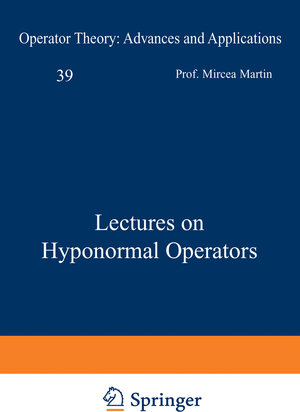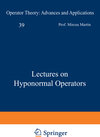
×
![Buchcover ISBN 9783034874687]()
Inhaltsverzeichnis
- I: Subnormal operators.
- 1. Elementary properties and examples.
- 2. Characterization of subnormality.
- 3. The minimal normal extension.
- 4. Putnam’s inequality.
- 5. Supplement: Positive definite kernels.
- Notes.
- Exercises.
- II: Hyponormal operators and related objects.
- 1. Pure hyponormal operators.
- 2. Examples of hyponormal operators.
- 3. Contractions associated to hyponormal operators.
- 4. Unitary invariants.
- III: Spectrum, resolvent and analytic functional calculus.
- 1. The spectrum.
- 2. Estimates of the resolvent function.
- 3. A sharpened analytic functional calculus.
- 4. Generalized scalar extensions.
- 5. Local spectral properties.
- 6. Supplement: Pseudo-analytic extensions of smooth functions.
- IV: Some invariant subspaces for hyponormal operators.
- 1. Preliminaries.
- 2. Scott Brown’s theorem.
- 3. Hyperinvariant subspaces for subnormal operators.
- 4. The lattice of invariant subspaces.
- V: Operations with hyponormal operators.
- 1. Operations.
- 2. Spectral mapping results.
- VI: The basic inequalities.
- 1. Berger and Shaw’s inequality.
- 2. Putnam’s inequality.
- 3. Commutators and absolute continuity of self-adjoint operators.
- 4. Kato’s inequality.
- 5. Supplement: The structure of absolutely continuous self-adjoint operators.
- VII: Functional models.
- 1. The Hilbert transform of vector valued functions.
- 2. The singular integral model.
- 3. The two-dimensional singular integral model.
- 4. The Toeplitz model.
- 5. Supplement: One dimensional singular integral operators.
- VIII: Methods of perturbation theory.
- 1. The phase shift.
- 2. Abstract symbol and Friedrichs operations.
- 3. The Birman — Kato — Rosenblum scattering theory.
- 4. Boundary behaviour of compressed resolvents.
- 5. Supplement: Integral representations for a class of analytic functions defined in the upper half-plane.
- IX: Mosaics.
- 1. The phase operator.
- 2. Determining functions.
- 3. The principal function.
- 4. Symbol homomorphisms and mosaics.
- 5. Properties of the mosaic.
- 6. Supplement: A spectral mapping theorem for the numerical range.
- X: The principal function.
- 1. Bilinear forms with the collapsing property.
- 2. Smooth functional calculus modulo trace-class operators and the trace formula.
- 3. The properties of the principal function.
- 4. Berger’s estimates.
- XI: Operators with one dimensional self-commutator.
- 1. The global local resolvent.
- 2. The kernel function.
- 3. A functional model.
- 4. The spectrum and the principal function.
- XII: Applications.
- 1. Pairs of unbounded self-adjoint operators.
- 2. The Szego limit theorem.
- 3. A two dimensional moment problem.
- References.
- Notation and symbols.




